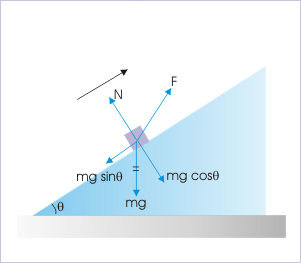| << Chapter < Page | Chapter >> Page > |
A block on an incline

(i) work done by external force ( ) during round trip
The most striking aspect about the external force, "F", is that we do not know either about its magnitude or about its direction. We have represented the external force on the force diagram with an arbitrary vector. Further, external force, F, acts only during up journey. Note that the block is simply released at the end of upward journey. It means that we need to find work by external force only during upward journey.
The kinetic energies in the beginning and at the end of "upward" motion are zero. Note the wordings of the problem that emphasizes this. From "work - kinetic energy" theorem, we can coclude that sum of the work done by all three forces is equal to zero during upward motion. It is, therefore, clear that if we know the work done by the other two forces (normal force and gravity), then we shall find out the work done by the external force, "F", as required.
Work done by the forces normal to the incline is zero. It follows then that we do not need to consider normal force. According to "work-kinetic energy" theorem, the sum of work done by gravity and external force for upward motion is zero :
Thus, we need to compute work done by the gravity in order to compute work by the external force "F". Now, the component of weight parallel to incline is directed downward. It means that it (gravity) does negative work on the block while going up. The component of gravity along incline is "mg sinθ", acting downward. Work done by gravity during upward journey is :
Hence, work done by the external force, "F", during the round trip is :
(ii) Kinetic energy at the end of round trip :
Initial kinetic energy of the block is zero. The kinetic energy is increased by the work done by the forces acting on the block. According to work - kinetic energy theorem :
Total work done during round trip by external force, "F", is 100 J as computed earlier. Total work done during round trip by gravity is :
Hence, total work done during round trip is :
For understanding purpose, we again emphasize that total work done during upward motion is zero as block is stationary in the beginning and at the end during motion up the incline. The positive work done by external force, "F", is canceled by the exactly same amount of negative work by gravity. The net work is done in only downward motion by the gravity, whereupon kinetic energy of the block increases.
Finally, we should note that this example was specially designed to illustrate calculation of work by unknown force indirectly, using "work-kinetic energy" theorem. This application, however, depends on the specific situation. For example, had the incline been rough, we would be required to consider friction force as well. This friction, in turn, would depend on the external force. As such, we would not be in a position to calculate work by "unknown" force indirectly as in this case. Clearly, in that situation, we would need to know the external force as well to apply "work-kinetic energy" theorem.
We summarize important aspects of work - kinetic energy theorem as :
1 : Generally, significance of "work-kinetic energy" theorem is not fully appreciated. Often, it is convenient and more intuitive to use laws such as "conservation of energy" in general or "conservation of mechanical energy" in mechanics. But we should know that mathematical formulations of these generalized conservation laws, as a matter of fact, are extension of this theorem.
2 : We should understand that kinetic energy and work are general concept not limited to any class of forces such as conservative forces. For this particular reason, we selected some examples involving friction (non-conservative force) to emphasize that the "work-kinetic energy" theorem is not limited to conservative force.
3 : The "work-kinetic energy" theorem considers works by all the forces working on the body or equivalently work by the "net" force. Unlike force analysis, application of "work-kinetic energy" theorem neither requires coordinate system nor free body diagram.
4 : Application of "work-kinetic energy" theorem is particularly suited for situations in which there is no change in the kinetic energy. This, sometimes, allows us to calculate work by even "unknown" force.
We derived mathematical expression of work-kinetic energy theorem in relation to constant force. We restricted our consideration to constant force to keep the discussion simple.
Here, we set out to establish work - energy theorem for an external force "F", which varies with displacement (r). We consider a particle of mass "m" moving along a straight line under the application of force "F". The work done in moving the particle by a small linear distance, "dr", is :
Let us also consider that force and displacement are in the same direction. This linear consideration is a convenient set up for even two or three dimensional cases. In general case also, we can compute work and kinetic energy in three mutually perpendicular directions of the coordinate system considering components of force and displacement in respective directions. Each of the computation in mutually perpendicular directions is a linear consideration.
Now,
Hence,
Integrating for limits corresponding to initial and final position of the particle,

Notification Switch
Would you like to follow the 'Physics for k-12' conversation and receive update notifications?